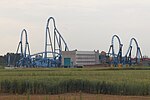Zadra (roller coaster)
2019 establishments in PolandAccuracy disputes from March 2022Hybrid roller coastersHypercoastersOperating roller coasters ... and 4 more
Roller coasters in PolandRoller coasters introduced in 2019Roller coasters manufactured by Rocky Mountain ConstructionSteel roller coasters

Zadra is a steel roller coaster located at Energylandia in Zator, Poland. It was built and designed by American manufacturer Rocky Mountain Construction (RMC). The ride opened in 2019. It uses RMC's patented I-Box Track, which consists of a steel track on wooden supports. It is the first coaster to be built from the ground up using the I-Box Track, rather than using an existing structure. Zadra reaches a height of 62.8 metres (206 ft) making it tie for the tallest RMC steel rollercoaster in the world alongside Iron Gwazi, which has a similar layout. It has a maximum speed of 121 kilometres per hour (75 mph), and features three inversions.
Excerpt from the Wikipedia article Zadra (roller coaster) (License: CC BY-SA 3.0, Authors, Images).Zadra (roller coaster)
Krakowska, gmina Przeciszów
Geographical coordinates (GPS) Address Website Nearby Places Show on map
Geographical coordinates (GPS)
| Latitude | Longitude |
|---|---|
| N 50.001944444444 ° | E 19.403055555556 ° |
Address
Zadra
Krakowska
32-641 gmina Przeciszów
Lesser Poland Voivodeship, Poland
Open on Google Maps





